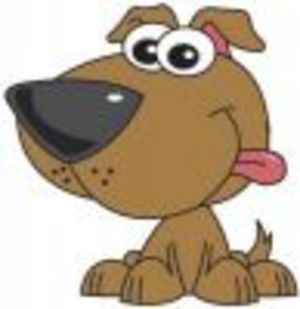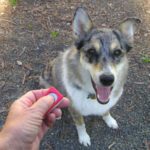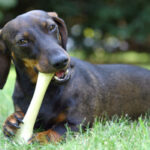It seems like a rather backwards way of doing things, but because of the tremendous variety of choices in commercially-produced dry dog food, it is actually easier to list the ingredients in – and quickly eliminate – the foods you want to avoid than it is to list what you want.
If you have been seriously researching this topic, and you’re still looking for some solid advice, this article is going to offer several top-rated, highly-recommended brands of commercially-available dry dog food, along with a home-made concoction from the nationally-recognized, homeopathic vet, Dr. Richard Pitcairn, which will help your pet’s diet to be nutritionally optimized.
Pitcairn devotes a whole book to proper diets for cats and dogs: “Dr. Pitcairn’s Complete Guide to Natural Health for Dogs and Cats” was published in 2005. He offers home-made supplements to add to any store-bought pet foods so the animal is assured of receiving proper nutrition.
Pitcairn says the most-likely minimum values offered in many store-bought kibbles are 18 percent protein, 9 percent or less of fat, and 67 percent carbohydrates. The “minimum recommended values” for dogs are 18 percent protein and 5 percent fat. The fact is that the natural diet of wolves (from which dogs are descended) is 54% protein and 43% fat. Pitcairn suggests adding fresh, wholesome, organic, pesticide-free vegetables, meats, and dairy products to your dog’s diet to fulfill optimal, not minimal, requirements.
Another vet, Dr. T. J. Dunn, who has had 37 years of experience with dogs, suggests a diet with a minimum “guaranteed analysis” of 30% protein and at least 18% of fat. He says the food should also contain omega fatty acids and preservatives such as vitamin E and/or vitamin C. (www.thePetCenter.com)
Pitcairn (and his wife and co-author, Susan) recommend making a “Healthy Powder” and adding it to your dog’s food bowl every day. The ingredients are listed so you can add this nutritional supplement to easily-found and highly-recommended store-bought dog foods. Pitcairn’s book also offers many fine, home-made preparations for a truly well-balanced dog-food diet, but this article is to help you choose a readily-available, quality dog food, which you can jazz up with home supplements.
Pitcairn’s Healthy Powder:
2 cups nutritional yeast (hard-to-find but preferable) or brewer’s yeast; 1 cup lecithin granules; ¼ cup kelp powder; 4 tablespoons Group 1 bone meal powder (to be listed); and (optional) 1,000 mg. Vitamin C (ground) or ¼ teaspoon sodium ascorbate. Mix all ingredients together in a 1-quart container and refrigerate.
Group 1 Bone Meal Powder can be attained from KAL, Inc. Bone Meal, which has 1500 mg. calcium and 750 mg of phosphorus per teaspoon, the desired ratio; Solid Gold contains 1369 calcium and 684 mg of phosphorus.
Pitcairn also lists a 2nd group of products with about ½ of the foregoing ingredients, but the used-amounts can be doubled so the ratios stay the same. He is listing brands he could find easily from health-food or pet-supply stores. Getting the “healthy powder” ingredients is a huge part of the battle for creating a nutritionally-complete diet for your dog. Pitcairn lists 3 products in this second category: NaturVet bone Meal; Now Bone Meal Powder, and Solgar Bone-All.
Pitcairn lists websites where one can find these products; without them, his recipe could be useless. The contact suppliers are: www.solidgoldhealth.com; www.naturvet.com; www.nowcatalog.com; http://solgar.com; and he suggests searching the Web for “KAL bone meal.”
Pitcairn’s recommended use of “healthy powder” with commercial dog foods: Add 1 to two teaspoons daily for small dogs (or cats); 2 to 3 teaspoons for medium-sized dogs; and 1 to 2 Tablespoons daily for large dogs. Dog sizes: Toys weigh up to 15 pounds; small = 15 to 30 pounds; medium = 30 to 60 pounds; large = 60 to 90; and giants weigh over 90 pounds.
According to Pitcairn, the average daily caloric needs for dogs, by weight, are listed as follows. (Understand that the dog’s weight is listed in pounds; the “caloric content” = “kcal” per day.) A 10-lb. dog needs 410 kcalories; 15-lb needs 550; 25 lb. needs 840; 40 pounds needs 1150; 50 lb. needs 1380; 60 pounds needs 1555; 70 lb. needs 1690; 80 pounds needs 1890; and a 100-lb. dog needs 2270 kcal per day.
There is a direct correlation between fat and protein; the more fat in the diet, the more protein that is needed. A dog will eat less of a fattier diet to satiate. “That’s why a dog can become undernourished if you add [fatty] oil or meat drippings to its food without increasing the protein, vitamin, and mineral content accordingly.” (Pitcairn)
By now, we’ve all learned to read labels to determine what’s in our food products. Ingredients are listed in decreasing order of the amount of product it contains. Then, the nutrition facts are broken down into fat, cholesterol, carbs, protein, etc.
With pets, the nutritional contents are listed under “guaranteed analysis.” Most bags are marked in descending order of crude protein, crude fat, crude fiber, moisture, calcium, phosphorus and other vitamins and minerals.
From a bag of “quality” dog food recommended for our dog by our vet, the list is 21% minimum protein, 10% minimum fat, 3% maximum fiber, 10% maximum moisture, 1% calcium, and .9% phosphorus. [This is a popular premium dog food and it still lacks some necessary ingredients; thus the need to use Dr. Pitcairn’s healthy powder.] Then you should look at the order of ingredients that provide those food values.
According to Niki Tudge, a certified dog trainer and founder of “www.TheDogSmith,” food for dogs should list the first ingredient as protein. This should not contain animal by-products or inferior grains. Meal and bone meal often come from “the five D’s: dead, diseased, dying, disabled, and drugged animals.” “Inferior grains” include corn, wheat and soy, which falsely inflate the protein numbers in the analysis.
Fats” should provide a natural balance of Omega-3 and Omega-6 fatty acids, without added flavors and food colorings. She recommends chicken fat, catfish meal, flaxseed meal and eggs.
There should be no chemical additives or preservatives. Some premier dog foods add live probiotics to support the immune system, which is good.
Healthy ingredients (from “Instinct” produced by Nature’s Variety in Lincoln Nebraska): include foods like Tapioca, a grain-free and gluten-free product without any known allergies. Pumpkin seeds are a good source of fiber, vitamins, and minerals. So are carrots. Blueberries and cranberries supply anti-oxidants.
For protein, consider chicken or chicken meal, rabbit, duck, turkey, beef, lamb, salmon, or venison.
Look for quality among the premier brands in good pet food stores. Use them as your “gold standard” for dog food. If you must buy cheaper or less-nutritious food, consider supplementing with Dr. Pitcairn’s powder. Most grocery stores do not offer an acceptable, high-quality dog food.
Of course, every product line offers multiple choices. Dogs with allergies, dogs with chronic diseases, pregnant bitches, dogs recovering from surgery, and dogs at different stages of life have different needs. You must know your own dog, and you should get some guidance from your vet about your dog’s individual needs.
The following national brands are highly-recommended by vets, breeders, trainers and dog owners themselves.
Blue” by the Blue Buffalo Company uses no chicken or poultry by-product meals. They promise they do not use artificial flavors, colors or preservatives. They do not use corn, soy or wheat products. Blue guarantees they use only the finest natural ingredients, plus the “active nutrients and antioxidants of our exclusive, cold-formed LifeSource Bits,” which are a “precise blend of vitamins, minerals and antioxidants selected by holistic veterinarians and animal nutritionists.” Http://bluebuff.com/why-choose-blue.shtml.
Nature’s Variety offers “Instinct,” which includes kibble and cans and promises to be 100% grain-free and gluten-free. They advertise that “over 90% of the protein is from meat, poultry, or fish.” They guarantee their products will improve skin and coats and they promise their foods are “complete and balanced for all life stages and all breeds.
Nature’s Variety also offers the “Prairie” brand, which is guaranteed to be “100% natural – no additives or preservatives.” They offer kibble in chicken, beef, lamb, venison, and salmon. Their fruits and vegetables include broccoli, apples, carrots, peas, spinach, blueberries and cranberries. See www.Naturesvariety.com.
Pinnacle” earns a place among the best for its “holistic formulas, organic ingredients, quality protein sources, allergy-free (ingredients), and unique oxygen-barrier bags.” Their bags offer a 98.5% oxygen-barrier that supposedly “improves palatability, prolongs vitamin potency, protects against oxidation, and locks out moisture and pests.” Once opened, they recommend using the product within 90 days.
Pinnacle’s ingredients for its “Trout and Sweet Potato Formula” are: “Trout, oatmeal, herring meal, oat flour, canola oil, sweet potato, calcium carbonate, flax seed, and organic quinoa” plus some other nutritionally-sound ingredients, which include several vitamins. This is supposed to be a “sensitive stomach formula.” Find Pinnacle products at www.pinnacledog.com. Its main location is in Irwindale, CA.
“Breeder’s Choice” is also located in Irwindale, CA and started making “Avoderm Natural” products in 1947. Their products include avocados for “an excellent balanced source of nutritional essentials for your dog’s skin and coat health and good health in general.
A sample of their ingredient list for the “Natural Adult Lamb Meal and Rice” formula includes “lamb meal, ground whole brown rice, ground whole rice, oatmeal, rice bran, chicken fat, flax seed, avocado oil,” and more “naturally preserved, antioxidant-rich” ingredients. See their site at www.avodermnatural.com.
Top-quality dog foods will cost about $2 per pound.
According to www.consumersearch.com/dog-food, three of the top-rated dog food brands are: Orijen (about $35 for a 15.4 pound bag); Innova EVO Dog Food (about $25 for a 13.2 pound bag); and “Chicken Soup for the Pet Lover’s Soul Dog Food” (about $23 for an 18-pound bag.)
Our local Superpetz pet-supply store recommended Wellness, Dick Van Patten’s Natural Balance, Natural Choice by Nutro, Solid Gold (holistic food), Eukanuba’s “Naturally Wild,” Iams, and Hill’s “Science Diet.”
Every formula is different, but quality within a “good” brand tends to stay consistently high. Some well-recognized brands sometimes try to “cheat” a bit on the formula, allowing new brands to move in and become the savvy-dog-owner’s new choice.
Now that you know what you’re looking for, read labels carefully and get a vet-based recommendation for your particular pet. If you buy a lower-quality food, supplement it with Dr. Pitcairn’s “healthy powder.”
Remember, a higher-quality food means you feed less, and there will be less waste. In fact, clean-up should be easier, less messy and less smelly. That’s a huge advantage of good feeding.
Food makes the dog and can extend its quality of life by years. Do the best you can by your “best dog-friend,” and (s)he will, in turn, love you for a longer, better-quality life.
Sources:
Richard H. Pitcairn, DVM, Ph.D., and Susan Hubble Pitcairn, Dr. Pitcairn’s Complete Guide to Natural Health for Dogs and Cats. Rodale, 2005. Chapter 4: “Easy-to-Make Recipes for Pet Food.”
Pinnacle pamphlet. “Trout and sweet potato dry holistic formula.” Website at www.Pinnacledog.com.
Breeder’s Choice “Avoderm Natural” pamphlet. “Natural Adult Lamb Meal and Rice.” Website at www.avodermnatural.com.
Nature’s Variety pamphlet. “Raw diets, “Instinct,” and “Prairie” brands of dog food. “Our philosophy; our ingredients.” “Instinct” pamphlet: “Healthy ingredients.” Website www.naturesvariety.com.
Http://www.consumersearch.com/dog-food. Best dog food” and “Dog food reviews.” Retrieved 8-13-09.
Http://bluebuff.com/why-blue/why-choose-blue.shtml. “Why Blue?”
Niki J. Tudge, owner and founder of “www.TheDogSmith” and a certified dog trainer. “Do You Understand Guaranteed Analysis?” Http://www.articlebase.com/nutrition-articles. Posted July 7, 2009. Retrieved 8-13-09.
Dr. T. J. Dunn, Jr., DVM, Director of www.thepetcenter.com. What Is the Best Food to Feed a Dog?” Retrieved 8-13-09.






